The iconic Land Rover Defender – the one most people know from safari shows – had an aluminum body, didn’t have carpets – or air bags – but did have a 182 horsepower V8 under its hood that averaged about 13 miles-per-gallon.
It was last available new (in the United States) back in ’97.
A new Defender arrived in 2020 – and this time, it came standard with carpets.
Plus a few other things.
And now, a new thing!
What It Is
The Defender is a medium-small (depending on configuration) SUV known – back in the day – for being one of the most off-road capable SUVs ever made.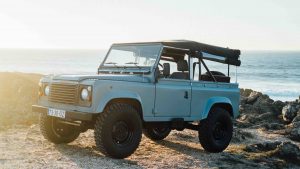
The original model, which was sold without major updates for decades, was marginally capable on-road, due to its spartan/uncarpeted interior, underpowered and gas-hungry ancient (even then) engine and a rugged but primitive suspension system that was great for tracking lions in the African bush but alarmingly unsteady on American highways.
The new Defender attempts to retain the off-roading capability with the luxury – and on-road stability – most SUV buyers expect today.
And now it’s available with a supercharged V8 that makes 518 horsepower.
The modern Defender comes in 90 (two-door/two row) and 110 (four-door/three row) versions, just like it used to – with the base P300 90 trim stickering for $47,700.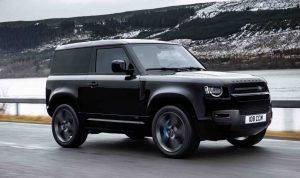
The same trim with a third row (110) stickers for $50,500.
These two come standard with a turbocharged 2.0 liter four cylinder engine paired with an eight speed automatic transmission and a full-time four-wheel-drive system with a two-speed transfer case and four-wheel-drive Low range, for leverage in deep snow and off-road.
If you want more than a four, the P400 swaps that out in favor of a turbocharged 3 liter (inline) six/mild-hybrid drivetrain. The two-row/two-door 90 series version of this Defender stickers for $59,500 to start; the three-row 110 variant lists for $65,100 to start and gets some additional features – including a panorama sunroof, LED headlights and a premium 15 speaker Meridian surround sound system – beyond the engine upgrade.
If you’d like a V8 to go with that, Land Rover offers a supercharged one in the 525 trims, available in both two and three-row versions. Prices for these start at $102,200 for the 90 and $105,400 for the 110.
A top-of-the-range 110 Carpathian Edition – with unique-to-this-trim grey satin paint and 22 inch gloss-black-finished wheels and a rotary knob-controlled trailer back-up feature stickers for $112,200.
What’s New
The V8 returns!
When Land Rover resurrected the Defender for the 2020 model year, it was only available with the four and the six. That was apparently not enough for traditionalists, who prefer their Defenders with more than just that under the hood.
And so, it’s back – with nearly three times as much horsepower as the Defender’s ‘90s-era V8 conjured
There’s also a new/larger LCD touchscreen option as well.
What’s Good
Tremendous off-road capabilities are standard – without the formerly standard on-road costs.
Unique and useful features such as the ’90’s available/configurable first row jumpseat in between the driver and front passenger’s seat that lets three ride up front, expanding the two-row’s seating capacity to six.
The V8 is back – in triplicate!
What’s Not So Good
The V8 is expensive; six figure starting price for three times the power of the old V8.
Two-row/two-door 90 version hasn’t got much room for cargo (15.1 cubic feet).
Hugely useful first row/three-across jumpseat option isn’t available with the 110.
The new Defender’s standard 2.0 liter turbocharged four cylinder engine is half the size – literally – of the old Defender’s standard 4.0 liter V8 engine, which was descended from a V8 GM designed, back in the 1960s.
But it makes 114 more horsepower than the old V8 (296 vs. 182 from the ’97’s V8) and it makes much more torque, sooner (295 ft.-lbs. at just 1,500 RPM vs. the old V8’s 233 ft.-lbs. at 3,300 RPM).
Instead of the four speed automatic transmission with one overdrive gear, the new Defender has an eight speed with multiple overdrive gears. Which is why it can manage 18 city and 21 highway vs. the previous Defender’s 14 MPG in the city and not much better highway, where it struggled to maintain 70 because of its underpowered engine and not-exactly wind-cheating aerodynamics.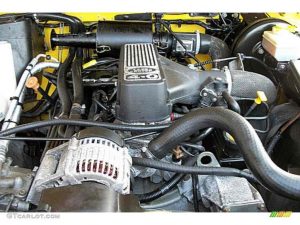
The next-up option is a 3.0 six that’s both turbocharged and hybridized. A 48 volt electrical system cycles the gas side of the drivetrain off as often as possible, as during coasting and deceleration – providing additional boost during acceleration.
The combo produces a total of 395 horsepower and 406 ft.-lbs. of torque, both figures competitive with today’s V8s while more or less matching the mileage figures of the 2.0 liter four. City mileage is slightly less – 17 MPG. But highway mileage is slightly higher – 22 MPG.
Performance is also better.
A Defender 90 with the turbo’d six/mild hybrid set-up can get to 60 in about 6.5 seconds vs. about 7.4 for the four cylinder-powered iteration.
Versus about 12 for the old Defender V8.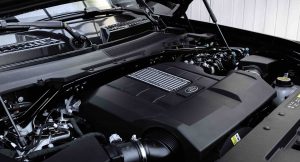
The new V8 option knocks that down to just over 5 seconds. Of course, you pay for that at the pump. This version of the Defender doesn’t match the mileage figures of the four – or the hybrid six. It almost matches the mileage figures posted by the old V8 Defender.
But 15 city, 19 highway goes down a lot better when you can get to 60 twice as quickly – and a lot faster than 70, on the highway. And with almost 24 gallons of gas in the tank, you won’t have to stop before you’ve put more than 400 highway miles behind you.
Regardless of engine, every Defender comes standard with a beefy full-time four wheel-drive system and two-speed transfer case.
Even the four cylinder versions can tow up to 7,700 lbs. and V8-equipped versions kick that up to 8,200 lbs.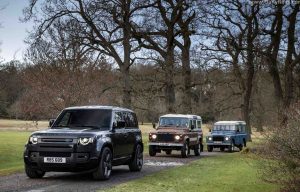
On The Road
It used to be either – or.
You could buy an off-road vehicle like the old Defender (and similar models like the old Ford Bronco, the old Jeep CJ, etc.) and be able to go places suitable for horses. Or you could buy something that could take you other places, in comfort.
You generally couldn’t buy both – in one.
Now, you can.
The new Defender can pick its way over ruts and rocks that would strand – or break – most other vehicles (including most crossovers, which may look like SUVs but are mostly based on cars and have light-duty underthings and don’t have two-speed transfer cases) while not making you wish you’d bought something else to get you to work.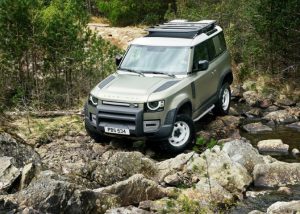
This is an engineering miracle equivalent to designing a Corvette or Porsche that could pick its way over rock and ruts and still run the fastest lap around a race track.
You won’t win a road race in the Defender. But you won’t lose – on the street.
The base-engined version has enough power to get up to highway speeds without making you wish you’d bought the optional engine. There’s enough in reserve to get to 100 – with more to go – which is fast enough for any remotely legal on-road driving in this country.
The little engine makes big torque and feels stronger than you’d expect, especially in the stop-and-go, where all of its torque is available essentially immediately as it is made at an engine speed just above a fast idle. It is not necessary to rev it to reach it.
The hybrid six has the same pull down low, with more reserve in the middle and higher ranges. The 48 volt mild hybrid system (similar to the system Mercedes uses in a number of its new models) cycles the six off when its power isn’t needed and provides additional thrust when that is needed. The chief benefit here – other than more power without using more gas (relative to the standard four) is the elimination of the uncivilized chuff-chuff off-on transitions you get (at red lights and so on) with the stop-start systems used in almost all current non-hybrid vehicles. These have 12 volt systems (and conventional starters) not originally designed to repeatedly re-start a stopped engine. You hear it – and feel it.
Here, you don’t.
The six also sounds better, though this is a subjective. Especially because it is an inline six – these being naturally revvy as well as naturally smooth – because they don’t require the heavy balancing needed by V6s to counteract the tendency of the latter layout to not be smooth.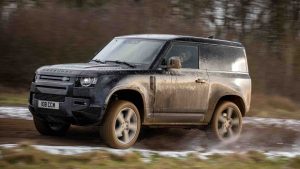
They’ve generally been disappeared from cars because there’s usually not enough room to mount them sideways – transversely – that layout being necessary in a front-wheel-drive layout, which is almost all modern cars except for higher-end cars.
And big SUVs like this one.
Of course, the V8 sounds best – and not just because V8s have a distinctly authoritative rumbly bass voice down low that rises to a bellow when roused. Add the menacing gear whine of a supercharger boosting a V8 and you arguably have a sound that’s priceless.
Land Rover charges accordingly.
You also have your choice of either two doors or four doors – and two or three rows of seats. This is in keeping with the way the classic (the ’90s were more than 20 years ago) Defenders were offered.
Both versions come standard with carpets.
The four-door 110 is significantly longer (197.6 inches) than the 90 (180.4 inches) with either-ors to match.
Because it’s more than 17 inches shorter, end to end, the 90 is more maneuverable in tight spots – often encountered on narrow off-road trails with steep drops on either side. It’s easier to decide to turn around. In the 110, you’re more committed because there may be no turning back.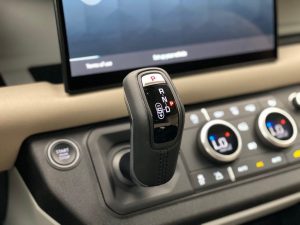
Literally.
On the other hand the, the 90 is more cramped. Not so much for passengers (though second row legroom is about two inches greater in the 110 (39.1 inches vs. 36.6 in the 90) but rather for their stuff. You’ve got 15.6 cubic feet to work with, which is about what you’d have available in a current mid-sized car, which isn’t much.
Actually, it’s more – because the Defender’s space is more usable as well as accessible, given the wide (and sideways) opening rear door and the tall roofline. Also, the area available isn’t walled off from the passenger compartment, so you can work with what you’ve got.
Or you can go with the 110 – and more than double the space available, to 34 cubic feet. It’s still not as much as you’d have in many smaller crossovers. But then, most of those aren’t set up to cross over much.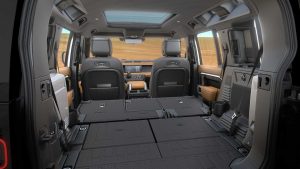
Plus, you can fold the second and third rows completely flat.
There is some functional overlap with the Discovery – the next-up model in Land Rover’s lineup. The Disco is a little bigger (longer) as it comes – because it comes only as a four-door. But it looks more like the generic crossover than the Defender, which looks a lot like it used to.
Just without feeling like it used to.
Interestingly, the current (2021) Disco doesn’t offer a V8.
Yet.
You can custom-outfit your Defender with an array of cosmetic and functional upgrades and optional equipment, some of it factory available and some of it dealer-added. These include a high-mount air snorkel (to prevent water from being sucked into the engine while fording deep water), side-mount ladder to get up to the roof – and a tent that mounts on the roof – to keep you out of range of lions and tigers and bears, oh my.
Just a few detractions from the overall package.
These include not being able to get the very handy first-row middle seat in the 110 model, which limits its passenger-carrying capacity to six in its three rows, vs. the possibility of just as many in the 90.
The other being that the V8 will likely prove to be out of most buyers’ range. If you want a V8 Defender, you’ll pay twice-plus the price of the base Defender with the standard four.
While the old Defender of the ’90s had a weak V8, it was standard – and people of average means could aspire to ownership.
Today, V8s are increasingly an indulgence of the extremely affluent only.
The Bottom Line
It’s no longer either – or.
And that’s pretty good!
. . .
Got a question about cars, bikes, Libertarian politics – or anything else? Click on the “ask Eric” link and send ’em in! Or email me at EPeters952@yahoo.com if the @!** “ask Eric” button doesn’t work!
If you like what you’ve found here please consider supporting EPautos.
We depend on you to keep the wheels turning!
Our donate button is here.
If you prefer not to use PayPal, our mailing address is:
EPautos
721 Hummingbird Lane SE
Copper Hill, VA 24079
PS: Get an EPautos magnet or sticker or coaster in return for a $20 or more one-time donation or a $10 or more monthly recurring donation. (Please be sure to tell us you want a magnet or sticker or coaster – and also, provide an address, so we know where to mail the thing!)
My eBook about car buying (new and used) is also available for your favorite price – free! Click here. If that fails, email me at EPeters952@yahoo.com and I will send you a copy directly!


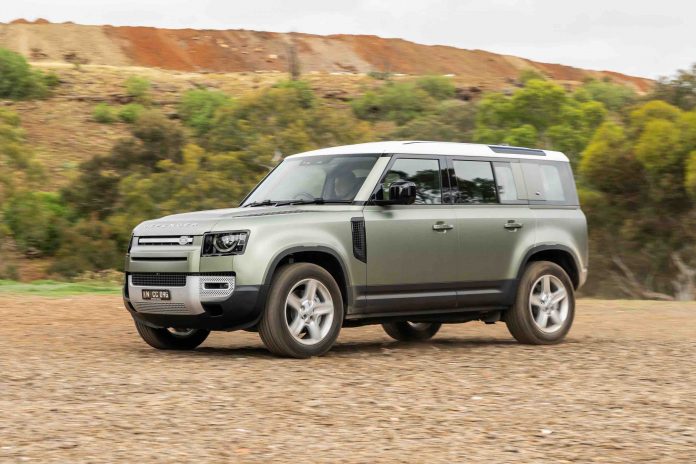













Fifty – freaking – thousand Dollars! Man, … was marrying Laura Croft ever even an option?
One thing about your reviews which occurred to me, our FJ, which gets similar gas mileage, require$ the high octane 91, I wonder what the Defender, and other vehicles, requires?
Eric wrote, “Tremendous off-road capabilities are standard”
THAT would be good video. (I mean, how Do You Know?) I used to love seeing the photos of the whoops they did in 4×4 mags. Video might be better? I haven’t seen a single photo of you with your gf sitting in the middle of a swamp in a 4×4, a.l.a. FJ WaterDragon-style.
Could be ’cause the FJ WaterDragon had an aftermarket snorkel & axel breather tubes? Idk. (Just messing with ya. …But still.)
Anyway, thanks for the thoughts above. Nice break from everything.
Question about that 22″ wheel/tire option with the new V-8……
Doesn’t that combo make the Defender almost worthless for anything that approaches semi serious off-road driving? I’m not trying to trash this setup; I really want to know.
Obviously, the lack of high profile tires means that the ride will be much rougher, and those pretty wheels more subject to damage. But let’s suppose we’re willing to accept those drawbacks, and drive off pavement much slower. Would the owner still be able to travel effectively over mud, snow, loose dirt or very light rock hopping?
I’d like to see this option package as anything more than an automotive oxymoron. But I just can’t imagine it would work. Please enlighten me, and other curious readers. 🙂
You’re right, Mike –
These short/stiff sidewall (and relatively fragile) 20 inch-plus alloy wheels make no sense… if you intend to go seriously off-road. A set of steel 16 or 17 inch wheels with M/S tires or all-terrain tires would be much better. Of course, few take these $100k-plus rigs off road. Which is a shame. It is like using a Lippizaner stallion to pull a hay cart…
The problem is that you can’t go with wheels that small without more work.
If I’m not mistaken, the smallest LR offers is an 18″ steelie, and that’s only available with the 4 cylinder. Once you step up to the 6 or 8, the larger brakes require the larger rims.
TFL found out the hard way on their fairly modest hill test, popping the bead on two tires in short order, due to the short sidewalls of the bigger wheel/ tire combo.
Fauxfender? No thanks. I was the caretaker of the son in laws ‘85 110 with V8, for the 5 years he and fam. were overseas. What fun, this old rig has soul this new version can’t match. They missed the sweet spot of updates that made sense vs. copycat everyone else – touchscreen in a Defender? Bleeeh.
“My wife yes, my dog maybe, my classic Defender never!”
I’ve been watching with interest the new Land Rover Defender. Like every vehicle, it has its pros and cons. Now that it’s been available for a little while, there have been more observations by reviewers, including actual off road use in places like Australia.
Offroad capabilities are actually pretty good compared to most 4WD vehicles. By some metrics, they are better than the previous Defender. It has better ground clearance thanks to front and rear independent suspension and the ability of the air suspension to raise the vehicle up, and it has a tighter turning radius, even in 110 (4-door) guise. The included offroad modes do help those with little to no experience go further offroad than they otherwise likely would have been able to. It has reasonably good water fording abilities and even has a slower crawl ratio.
However, it is also compromised offroad. This is sort of like a good point-and-shoot camera vs. a DSLR (or mirrorless, if you’re truly up to date) camera. A good driver in the old Defender vs. the new Defender will be able to get through more in a stock rig in the older model. While the independent suspension provides greater ground clearance, it offers vastly less articulation than the old solid axle system, which is at least as important, if not more so. All the electronics in the world will not overcome poor tires, and the most aggressive tires offered on the new Defender are rather limited and fragile/easily punctured (see TFL’s actual off road experience vs. a Wrangler and Bronco on YouTube). You may counter with “just buy better tires” but the larger rims mean shorter sidewalls and further limit capability. Add to that the fact that the electronics and fragile nature of the entire build argues against any serious offroad usage, at least not without extensive, and expensive, modification. Without this, a relatively mid-level Wrangler or new Bronco will easily walk away from it on the trail (as has been proven in many head-to-head comparisons already on YouTube).
Where the Defender is superior is in interior comfort and amenities. Even the base level Defender offers more luxury and refinement than the highest trims of Wrangler or Bronco do. It also tows better and has more engine options with more horsepower and better fuel mileage.
All this complexity adds to reliability challenges already present in a British make like Land Rover, notorious for its poor reliability. Already the new Defender seems to be struggling in this area. However, the new Bronco is also having teething problems, particularly with its hard top. Both have unnecessarily complex powertrains in an effort to improve fuel efficiency, but the Wrangler is slowly becoming similarly burdened with unnecessary complexity in that Jeep now mandates the V6 come in its mild hybrid form (unless you choose the manual transmission), or you can get a turbo 4, or a turbo-diesel with all the emissions/DEF garbage, or the impressive 392 Hemi V8 that includes full-time AWD instead of selectable 4WD. This segment should be a simple, rugged, reliable proposition, but it is rapidly morphing into a case study in how government regulations screw everything up.
I like that v8, but not that price tag.
“Tremendous off-road capabilities are standard – without the formerly standard on-road costs.”
I don’t buy the tremendous off-road capabilities stuff. Looking at the picture of the old version, if you heavily modified it (e.g. – jacked it way up, modified the suspension, added a skid plate, etc.) then you might have been able to use it to get to this trailhead in Colorado – https://www.14ers.com/php14ers/trailheadsview.php?thparm=sc01. Only heavily modified 4WD’s and ATV’s can get to 10,000 feet, and even then it depends on the driver. The new version? Ha! It would fall apart, even if you could jack it up, fix up the suspension and add a skid plate.
You The Man, Eric, as always! Thank you.
This is very nice and all, but it’s a bit too civilized to be a true Defender. It’s basically fulfilling the same role as the Disco.
Land Rover should have taken an evolutionary approach like Mercedes-Benz has been doing with the Geländewagen.
Eric, do you have any sense of how reliable the Defender will be, especially as compared to the atrocious reliability of the Range Rover models? The 90 with the inline-6 engine–I’m a Bimmer guy from way back and have a soft spot in my heart for inline 6 engines–seems to be a compelling package.
Thanks, Eric, for all your great work.
Jon
Hi Jon,
It’s difficult to say as regards a model that’s only been available for two years – barely. I hope that LR has tightened up its processes to achieve at least par with BMW, Benz and Lexus (the latter being a high bar). We’ll have to wait and see.
I would have preferred it if LR had offered just the six – without the 48 volt hybrid system. But you can thank the government for making that not happen!